by Michael Cropper | Oct 8, 2015 | Digital Marketing, Social Media, Tracking |
Many small to medium sized business are afraid of social media, are unsure what they should be doing on social media and spend an awful lot of time managing social media without any idea of what they are getting back from it. We’ve already covered how to monitor your social media activities and reviewed various tools to help you manage social media effectively. Now it’s time to take this one huge step further to automate virtually 99% of your social media accounts using technology.
If you’re a business owner or aren’t that tech-savvy then some of this may be a bit over your head, so get in touch and we can look to set up the same process for you with ease and show you how to use this system. The investment in this setup using free technologies will pay for itself within a matter of weeks within your business in time saved, allowing you to spend time improving other systems and processes to become more profitable.
Before people start jumping on the bandwagon about how social media should be personal, you should spend time crafting messages and treating every account differently etc. Bear with me. The reality for many businesses is that they quite simply don’t have time to be doing the work that large brands do as large brands have teams of people managing their social media activities in the background. The reality for the majority of small to medium sized businesses is that this is left to either a single marketing manager, a junior member of the marketing team or even the managing director to manage. For all of these people, social media management is not at the top of their priority list and is an area which can be made extremely efficient with technology and automation without compromising on the quality. On the other hand, if you feel that your business needs someone to be doing everything manually, then good on you, you’re probably wasting a lot of time as this is the equivalent of still using a dustpan and brush when you could just use a Dyson or a Roomba.
Now, on to the good stuff. Personally we use a whole host of technologies, automation techniques and manual interactions to manage our social media channels which works for us. Every business is different, so take what you will from this and if this could work for you, then great, you’ll be saving hours or time per week through the use of smart technologies.
The Manual Process
Before we jump into the automation, let’s just look at the common ways people identify content to share on social media channels. They are likely subscribed to either a daily, weekly or monthly newsletter from a variety of industry magazines and websites or they use a well-crafted set of followers on social media to manage their news feed effectively. We use a mixture of both, with the main @ContradoDigital Twitter account following relevant digital accounts that share some awesome news about the world of digital. As always, not everything is relevant for what our audience wants, so we need to filter out this so that the content that is shared is highly relevant to our audience who is interested in technology, innovation, digital marketing, security and general digital news.
Based on this, we review the content that is being published around the web and any content that is relevant we also share on our social channels, both company channels and my personal channels for Twitter, LinkedIn, Facebook and Google+. We already have technology in place to automate the majority of the social media management process which saves an enormous amount of time already but we wanted to go further and really push the boundaries of what is possible.
We use Buffer to add social media updates to our queue of scheduled posts to be posted out to all social media channels along with Bitly to track the engagement from our followers to understand what content they like to read about. The last piece of the puzzle is how to automate adding content to Buffer with ease. Traditionally we would either favourite a news story on Twitter or open that news story in the browser then use the Buffer Google Chrome plugin or Buffer App on mobile to add this to the queue. While not particularly difficult to do, adding a new story to the queue could take up to 2 minutes by the time the pages have loaded and everything has been completed. 2 minutes, multiplied by 6 posts per channel per day, multiplied by 20 days per month equates to around 4 hrs per month spending time adding content to social media channels for our audience. I’d guess that this is already significantly less than what you spend managing social media channels, but we wanted to go one step further and significantly reduce this to only 60 seconds per day.
What if there was a better way…
Introducing Automation using IFTTT
If you haven’t come across If This Then That (IFTTT) before, then quite simply this piece of free technology is designed to automate almost anything you can imagine that you are doing manually. The service links together web based technologies through the use of Application Programming Interfaces (APIs) which can be simplified as systems talking to other systems.
All modern and scalable web platforms have some kind of open API built in with them as they understand how this key functionality automates the work and grows their business. It is this what we’re plugging into to join the dots and save 4 hrs per month.
The logic behind the automation is as follows;
- When a Tweet is Favorited on Twitter
- Send this to Buffer to be automatically posted out to our followers who are interested in this content
There is a little more behind the scenes which we’ll talk through in a minute, but that is the gist of the setup.
The Process for Automating 99% of Social Media Management
So let’s just jump right into how to get this set up. Once set up, you will be saving hours of time per week managing your social media activities. Most businesses spend an hr or two per day managing social media activities. We spend 60 seconds per day as we’ve implemented the right technology to become more efficient.
Bitly
Set up a Bitly.com account if you don’t have one already. This is going to track how many people are clicking on the links that you are sharing on social media on a daily, weekly and monthly basis. Allowing you to improve performance of your social media activities over time.

Buffer
Set up a Buffer.com account if you don’t have one already. This is going to automate all of your social media posts by adding everything to a pre-scheduled queue. Allowing you to simply add a post to Buffer which will then be automatically posted to your default social media profiles that you can configure to send out an update at a set time of day/week as you choose.

Make sure you link your Buffer account with Bitly in the settings to track link clicking statistics through Bitly as we find this provides a bit more insight than Buffer. You also need to set your default social media profiles up. So if you have multiple social media profiles to manage, then set which are your default ones that you want to send updates to as these will be used with this automation setup.
Buffer has the ability to email updates to Buffer which will be automatically added to your queue which is what we’re going to be using to automate things. Find your Buffer Secret Email Address within your account settings;
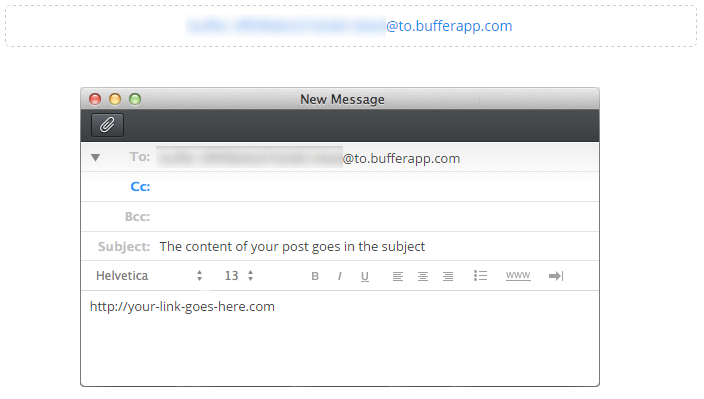
Now comes the clever part, using IFTTT.
IFTTT
Set up an IFTTT account if you don’t already have one. A component of IFTTT is that you create a Recipe which has Ingredients. Using this setup, you are essentially triggering an action to happen when something else happens beforehand.
In this example, we want to send an email to Buffer from Gmail when we Favourite a new Tweet on the @ContradoDigital Twitter account.

To do this, click on the “Create Recipe” button which will guide you through the process. As part of this process, IFTTT will connect with your Twitter account and your Gmail account. All fairly straight forward here. The part that you need to configure properly is what to contain in the email as there are specific shortcodes called Ingredients which need to be included so the correct information is sent over to Buffer to add everything to the right areas. Here you enter in your Buffer Secret Email Address from earlier along with the shortcode {{TEXT}} which will pull in the text from the Tweet you have just favorited and send this to buffer to use in the update;
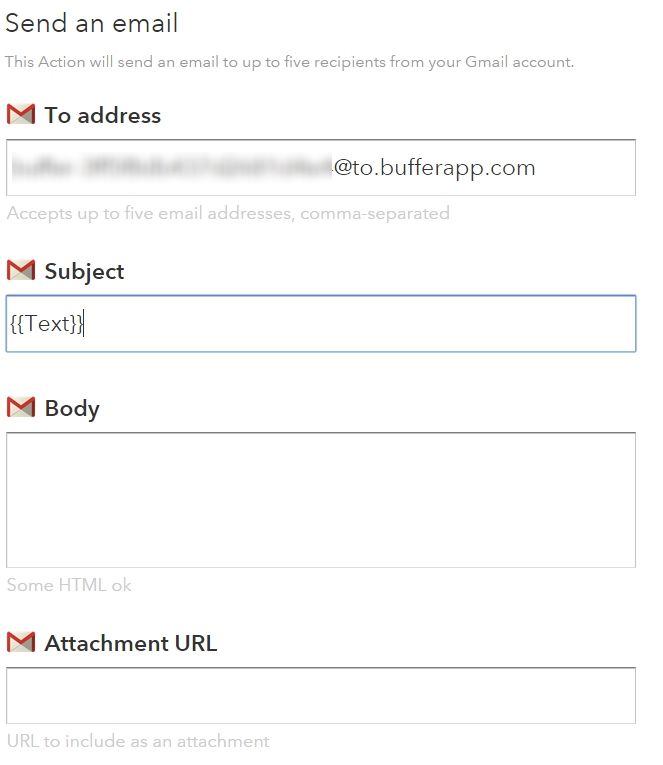
Once you’ve done this, it’s simple. Save the Recipe and start adding Tweets to your Favourites. IFTTT runs every 15 minutes or so, fully automated, so when it detects a new Tweet that you have starred then it will automatically post this out to Buffer.
All in all, meaning that we spend an average of 60 seconds per day managing our social media accounts, saving hours per month, allowing us to focus on more productive areas working with clients to implement similar technologies within their businesses to save them time and money.
If you’d like to make your social media accounts extremely efficient like we have and all of this has gone a bit over your head, then get in touch and we can look to set up the same process for you with ease. The investment in this setup using free technologies will pay for itself within a matter of weeks within your business, allowing you to spend time improving other systems and processes to become more profitable.
by Michael Cropper | Jan 15, 2015 | Data and Analytics, Digital Marketing, Events, PPC, SEO, Social Media, Technical, Tracking |
Just before Xmas I was invited to speak at the Creative Entrepreneur event at Media City in Manchester to share insights into how online retail is changing. In-between speaking, it was great to listen to other online retail experts to hear their thoughts about where things are heading. So we can take a look through some of the discussions points in this blog post.
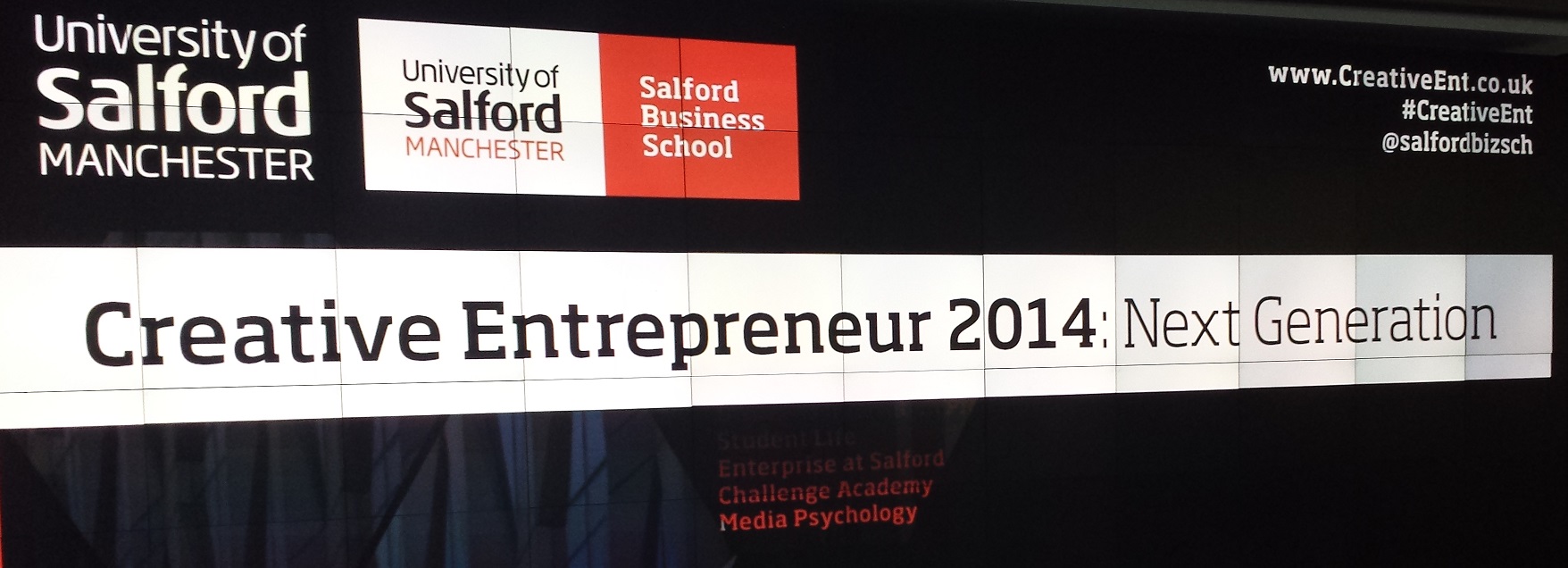
ASDA
First up we heard from Dom Burch, the serial speaker and senior director or marketing innovation and new revenue at Walmart UK (Asda). He shared his insights into how some of ASDA’s recent campaigns have been hugely successful in many aspects online and offline.
Dom’s first tip was around innovation and the importance of innovating throughout your entire business, regardless of how big or small you are. Innovation is key to long term and sustained growth. Simply dipping a toe in the water isn’t going to cut it here, Dom advised that you need to be giving projects at least 6 months to succeed (or fail!) so that you can be confident that you have exhausted all possibilities for the idea and had the time to gather data and assess the results accurately.
With all innovative ideas, you are starting with a goal of some kind for the business. Starting with ambitions to “become a big business” is equivalent to starting with the idea of “making a video go viral”. It’s simply the wrong approach to take and will inevitably lead to disappointment as goals are not hit. Instead, start with goals that are relevant for your business, goals that are in-line with your customer demands and goals that you can actually influence.
In between these ideas, Dom shared a few interesting statistics about ASDA;
- ASDA FM listeners have more people listening that Radio 1 and Radio 2 combined
- There are over 18 million customers who visit ASDA stores weekly
- ASDA’s website has over 300 million impressions every month
These are quite similar figures to what was announced last year at a digital marketing conference in Manchester.
With ASDA spending over £100 million per annum on broadcasting adverts, Dom’s approach was to get the PR team using Twitter, which was quite a challenge. Spending as little as 2 hours per week on Twitter, the newbie-to-Twitter PR team were already having a conversation with the editor of Vogue within 2 weeks. Where else could you get this kind of conversation going in 2 weeks? It simply wouldn’t be possible.
Another tip came in the form of doing something yourself first so that you know how to do it. This is something that I firmly believe in personally and in business. If you don’t at least understand what is happening, how can you ever hope to really manage this process? This is not to say you need to be an expert in every aspect as this would be impossible. Instead, it is hugely important to get a good grasp on every aspect within business and digital so that you can fully understand why things are being implemented and the reach they will ultimately have.
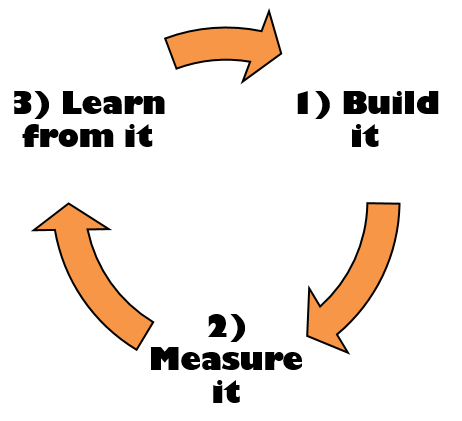
The simple process above will help you to build fast, fail quickly and innovate throughout your business at speeds you have never done before. Ideas are worthless, implementation is key and the only way to see what does and doesn’t work is to loop through the process as fast as possible, while giving every idea the time and energy to succeed.
Have a think for a moment, what are the 10 ideas that you have been talking about in your business last year? I can guarantee that there will certainly have been more than 10 ideas, but what were the 10 most important ideas? How many of these have you actually implemented, 5, 3, 1, none? Start the year off as you mean to go on. Run through these 10 ideas and measure everything to see how they impact your business. Capture the data and make informed decisions about the success of each campaign or idea.
For established businesses like ASDA, they aim to spend between 1-5% of their marketing budget on what Dom called “Trial and Error” campaigns which may or may not work. For businesses within the SME market, I would suggest this should be much higher as you are often still in the stages of experimenting with campaigns to see what works for your business. We naturally review and manage a lot of campaigns in the day to day work we do, although even we cannot tell you with 100% accuracy what will or won’t work for your individual business. We can certainly take into account the years of expertise and make a highly educated decision, although every business and every customer is different.
ASDA know that 74% of their customers are on Facebook, 20% are on Twitter and 15% of their customers watch YouTube daily. This information allows ASDA to invest their digital marketing spend in the right areas and not simply spend money on ‘more followers’ with no engagements. Their YouTube strategy focuses on how-to style videos and researching products which are broken down into 3 main groups;
- Hygiene content: Something that is core to what you do and for your core target market
- Hub content: Regularly created content designed to push this in front of your audience
- Hero content: Large scale campaigns to raise brand awareness, think about the epic Volvo Trucks campaign
The next of ASDA’s campaigns that was shared was with the involvement of Tanya Burr. Who you ask? Ask your teenage daughter if you have one. If you don’t, like me, then I also had to Google her to find out a bit more about her! She is described as a “Beauty, Fashion, Baking, Lifestyle Blogger & YouTuber” in a nutshell. And more than that, she has 1.2 million followers on Twitter. This is the reason ASDA worked with her, to reach this huge audience. The reach that ASDA’s products gained on social media was astronomical, just take a look through the number of views for each video that they produced together and you will start to understand how collaborations like this can pay off. Where else could you gain that kind of reach? To put things into context, Game of Thrones receives around 1.3 million views every week, which is less than what ASDA managed to reach with this collaboration. Likewise, Tanya Burr has more followers on Twitter than Sheryl Cole, Madonna and BBC Radio 1. Just because you have likely never heard of people like Tanya, doesn’t mean that they aren’t hugely successful.
When looking at YouTube videos specifically, always keep an eye out on the engagement levels and not simply the number of views of a video. Any brands that have a lot of views yet very few likes/dislikes means that they have likely paid a lot of money to drive traffic to the YouTube video and no-one liked it so they just bounced straight back out again. High engagement levels allow you to listen directly to your customers in ways like never before. ASDA’s videos with Tanya weren’t simply ‘buy this product’ videos, that’s boring and a fast way to drive customers away. Instead, they focused on food, health and wellness, beauty and style.
ASDA took this whole campaign one step further by creating the Mums Eye View YouTube channel which linked together their partnerships with Tanya Burr, Zoella and the Lean Machines. Google them all to grasp the scale of what is being achieved with strategic partnerships. This is a very young audience that ASDA was targeting here and one that has clearly paid off. With reports of as little as 2p per view of a YouTube video, 70% retention rate, 4 minutes minimum viewing time with an average of 7 minutes in length per video. You could only achieve these results with effective digital marketing that focuses directly on your customers. Not once did ASDA think “let’s make this video go viral”. What this also shows is that people like long form content on the web. No more do videos have to be 2 minutes in length, don’t be afraid of pushing the boundaries to meet customer demands.
This brings us nicely onto newspapers and traditional newspaper advertising. Quite frankly, no-one reads newspapers anymore, and I don’t say that lightly. Ask yourself, when was the last time you bought a newspaper? Personally, I can’t remember the last time I bought one, other than on the occasional times when I’m featured in one to keep as a little memento. Keep everything into context, could you seriously generate a response of someone looking at your advert for 4 minutes in a newspaper? I don’t need to answer that for you, it is clear. For ASDA, they know that 4/5 people don’t shop in ASDA and that is OK. So why spend £150,000 on a single press release in a national newspaper when 4/5 people of the people still reading newspapers aren’t ever going to be interested in ASDA anyway?
The summary of Dom’s keynote speech was that brands and businesses need to take a step back and see what is happening in the world. It’s time to start creating more content that relates to your audience.
Cyber Security
The next session was all about cyber security and the steps you can take to protect yourself. You need to look no further than the recent headlines about how many companies have been hacked into last year with millions of customer details stolen; eBay, Sony, Moonpig and endless more including 273 million customer details stolen from Yahoo and 250,000 customer details stolen from Twitter.
Some interesting statistics announced around cybercrime included that it costs the UK economy over £6.8 billion per year and the global economy £238 billion annually. With 81% of large businesses having experienced security breaches in 2014. The cost of a typical breach is now at £1.15 million, up from £600,000 in the previous year.
Some of the most common attacks are due to very basic hacking just after Update Tuesday. Windows PCs are updated every Tuesday with security patches that have been identified to keep your system and data safe and secure, yet so many people either ignore the messages on their computers or simply turn off the automatic updates. This is mad! As part of the weekly update from Microsoft, the hackers use this information as a shopping list of exploits on computers around the world they can attempt to get access to. If your system isn’t up to date, then you could be at risk.
Moving onto more sophisticated attacks such as DDoS attacks, which stands for Distributed Denial of Service attacks, these can bring down websites with ease. To the point at which you can actually purchase an attack on the black market to target a specific website for a specific amount of time. Unlawful and illegal hacking is turning into an underground commercial business. DDoS attacks are actually quite simple;

This method for DDoS are often using thousands, hundreds of thousands if not millions of computers from around the globe. For example, here you can see a short visualisation of a DDoS attack happening in real time on my personal blog a couple of years ago;
Have a read more about the full details if you are interested. The exact same thing happened to Mastercard, Visa and PayPal when they decided to stop sending funds through to the hacker group Anonymous. Whether you agree or disagree with this is another discussion all together and one that doesn’t have a simple answer. The important point here is that DDoS attacks are a real and present threat for businesses. While it is unlikely that you will encounter the wrath of some of the more prolific public hacking groups, the reality is that a lot of business websites for SMEs are hosted on cheap and nasty web servers that are poorly configured and have very little security built into them. Make sure your web server has the right protection in place to at least minimise the chances of DDoS attacks affecting you. The unfortunate reality is that if someone is determined enough to bring your website down, they will do. You can make it harder for this to happen though by having the right infrastructure in place for your website. Aren’t sure if your website and web server is protected? Then get in touch and we can review to check for vulnerabilities.
Moving away from hacking and looking at other types of data breaches now. Some of the most common data breaches often come in much simpler formats and often due to human error, aka. lack of awareness about threats. Threats including basic passwords on mobile and tablet devices to avoid automatic access to cloud based file storage systems for your company if a device is lot of stolen, to a deeper understanding of programming languages to avoid rookie mistakes.
Website vulnerabilities in particular happen for a number of reasons including unpatched software/content management systems/plugins, poor coding practices, poor server configuration, unencrypted data and more. Getting all of the above right is the absolute minimum businesses should be doing. Simply having a website built and not thinking about on-going updates is madness with how easy it is to exploit unloved websites. Every website should have regular and on-going maintenance to keep the website, content and data secure.
As of this year, there will be new EU Data Protection legislation that will be coming into force that businesses must adhere to. All of which is designed to move the current legislation into the digital age where customer data is collected at an alarming rate, often with very little visibility about what is being collected. This is likely to include full disclosure when data breaches happen so that customers are aware of what has happened. Far too often, businesses try and sweep large data breaches under the rug and hope that no-one will notice.
During the session, a live demonstration was given showing how easy it is for someone to steal your details – Even with my background, I was surprised at the level of things that can be done to steal personal details without you ever knowing what has happened. For example, simple things like clicking a link in an email can allow hackers to steal all of your saved login information in your browser. It really is that simple. Likewise, downloading a seemingly normal looking file from an untrusted source can result in a Key Logger being installed on your computer which will then be able to ‘read’ every single key you press, including your online bank account details and email passwords.
You may have heard about the infamous Stuxnet virus that swept the world almost by stealth last year. If you haven’t, you really need to read a few articles about this serious security threat; Wired, Business Insider, Wikipedia and what is even more worrying is that the source code for the virus is now publicly available on certain websites. As a quick overview if you haven’t come across Stuxnet before, the virus was designed specifically to find a physical controller located in power plants that controlled the heating/cooling of the nuclear material. As you can imagine, hacking into this and reporting an incorrect figure would lead to catastrophic results. This shows how sophisticated hacking has become. Some sources say that the virus was created by the US to target Iran’s nuclear facilities – how true this is, I don’t know. Other notable viruses including Duqu and Flame again highlight the level of sophistication that is happening right now.
Other common hacking attacks include the likes of SQL Injection attacks and Cross Site Scripting (XSS) attacks. Have a read up on these, again hugely important issues to be aware of and protect yourself against. Inexperienced and junior people working in digital are often oblivious to all of this type of information and most importantly how to protect against it. Always work with a company and people who are professional and have a very deep understanding of the industry they are working on. Remember the quote “If you think it’s expensive to hire a professional to do the job, wait until you hire an amateur”.
Now can you see why it is important to keep your systems, website and servers secure? Good, I’m glad the message has been received. If you don’t know what to do next, then get in touch and let’s have a chat.
Online Retail Panel
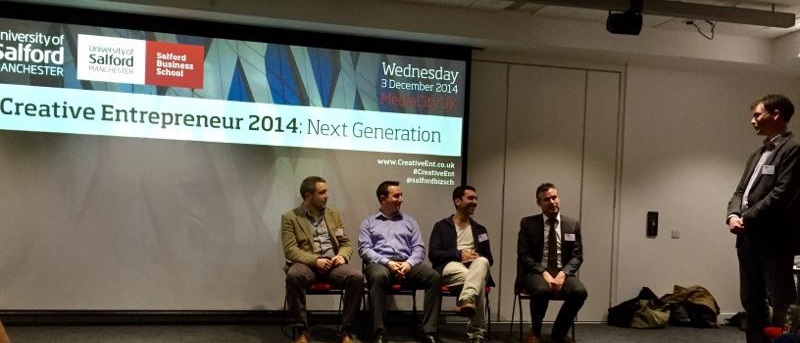
Next up was the panel that I was part of alongside three other digital agency owners in Manchester and London along with the Head of Online Retail for Iceland Foods, Andy Thompson. The session took a rather interesting turn to talk around a lot of digital topics about business growth through online retail, internal communication challenges and solutions along with some blindingly obvious opportunities for large brands to improve their sales online. The talks should be going online once they have been edited which you can look forward to watching, so for the meantime, here is a quick summary of the whole event and more information can also be found on the website;
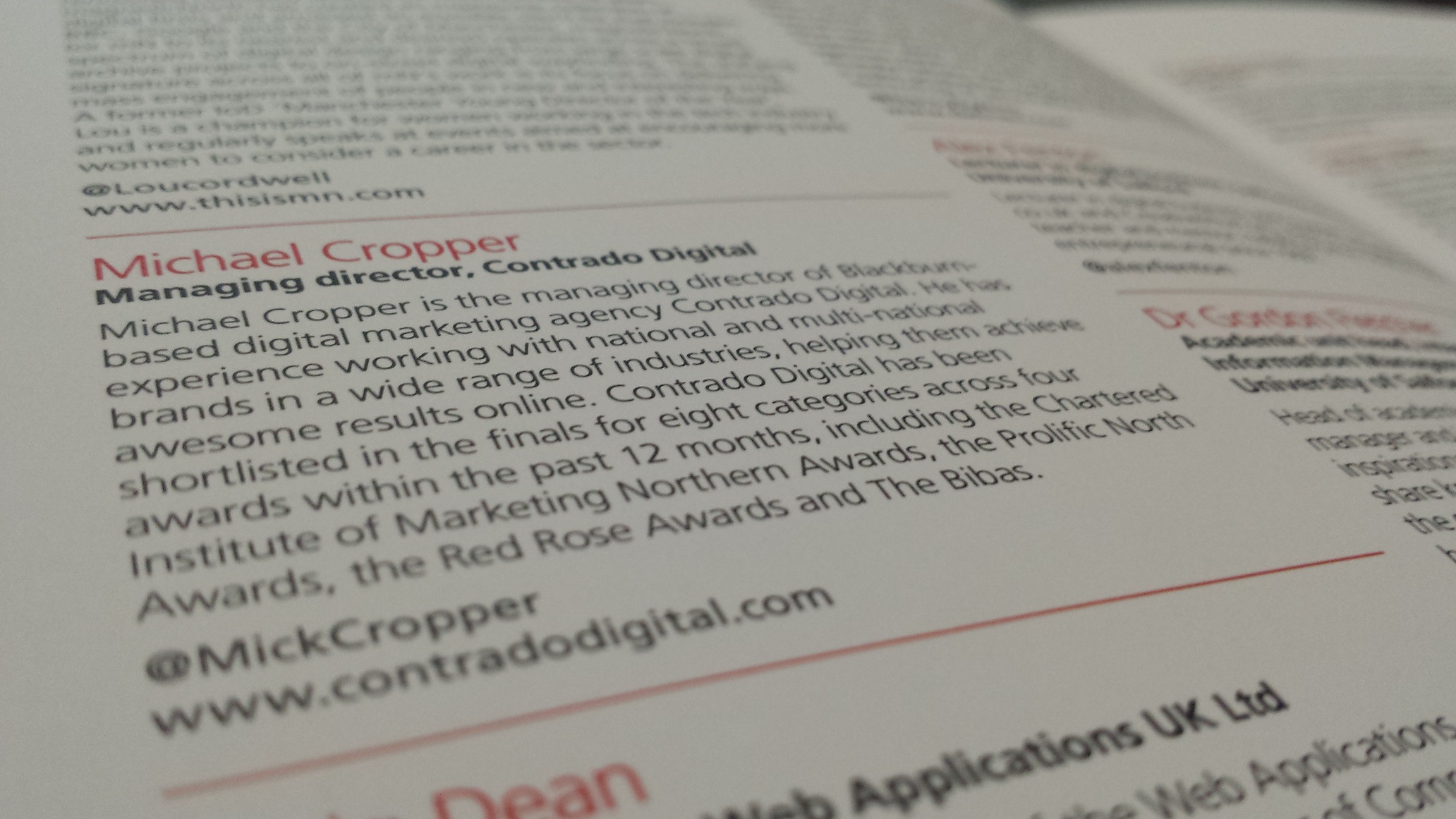
Digital Marketing, SEO and the Internet of Things
The last few sessions of the day are combined within this section. We heard from many different speakers and panellists in the final sessions with lots of great tips for businesses. One key message that is extremely relevant for the SME market is that you simply can’t have social media accounts without creative content. You need to be creating your own content and sharing this socially along with utilising other great content around the web to fuel your social media channels.
The Tales of Things by Oxfam
Oxfam was involved in a very interesting project with the University of Salford titled The Tales of Things. Oxfam have invested £1.4 million over the past 3 years with the aim of revolutionising business systems and processes through the use of digital technologies. The Tales of Things project was a very interesting one and one which I believe we will start to see more of over the next few years.
The idea was around selling donated products that also have a QR code attached to them. Customers looking at the item would then scan the QR code to listen to a short story from the person who donated the item. Oxfam found that this actually increased sales by 57% in the Manchester shop. They then extended this into Selfridges in London where celebrities donated items with the same concept behind. Within 14 weeks, they had this technology applied in 10 Manchester shops. This is ultimately a historical archive for objects that are traded, thus turning an object into something more than an object as it has a story behind it.
Personally I hate QR codes with a passion due to the way that they are misused in 99% of circumstances by businesses. Although in this instance with Oxfam, this is a really great way to bring things to live and genuinely adds value to the product being purchased and the customer experience.
This project has been on-going for a few years now so have a good read about the finer details over at the BBC, Oxfam and Tales of Things.
Cool Tech
Where would we be without a blog post talking about some cool technology that is on the horizon? Here is a really cool digital air hockey game that Tom Cheesewright and I played (which I think I won, Tom may disagree, not that I’m competitive in any way! );
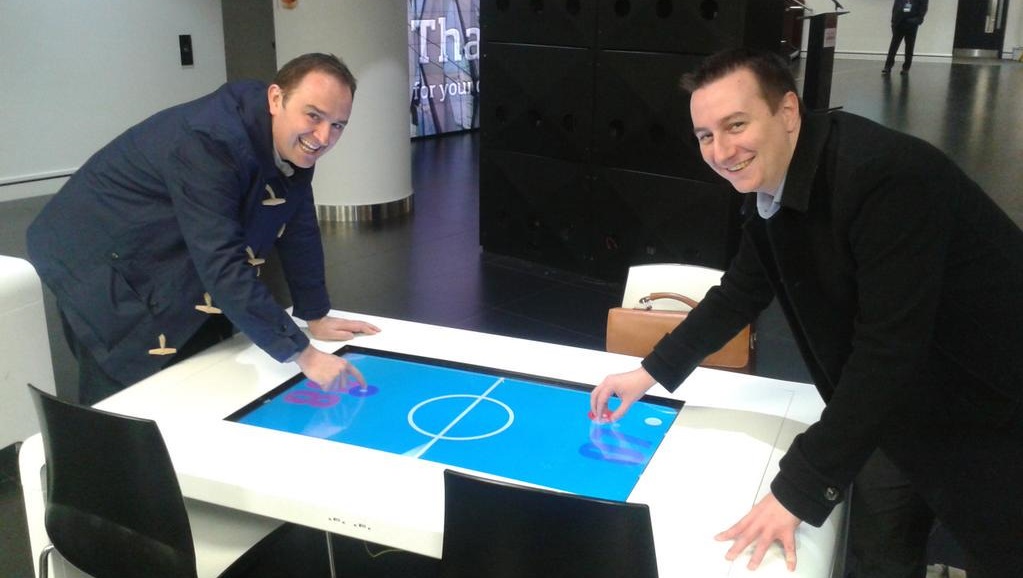
Image courtesy of Aleksej Heinze
And this was even more amazing, a 3D holographic projection (apologies for the poor quality, it was taken on my smartphone);
Summary of Event
Overall, the event was excellent with lots of great tips and advice to take away and implement. I’m sure there are a lot of questions about what you need to be focusing on in your business after the security discussions and digital marketing opportunities discussed above. Get in touch and we can talk things through with you to see how we can support the growth of your business.
Keep an eye out for next year’s event
by Michael Cropper | Dec 14, 2014 | News, Social Media |
2014 has been an exciting year where everyone has taken to social media to share their experiences in life. Let’s take a look what the world has been doing this year, how many of these do you remember?
YouTube
Facebook
Top 10 topics discussed on Facebook in the UK in 2014;
- Scottish Referendum
- Ice Bucket Challenge
- World Cup
- Premier League title race
- Conflict in Gaza
- Robin Williams
- Louis van Gaal takes over at Manchester United
- Ebola virus outbreak
- Champions League Final
- First World War Centenary
Top 10 places discussed on Facebook in the UK in 2014;
- Warner Bros. Studio Tour London
- Madame Tussauds (London)
- Tower of London
- The London Eye
- Old Trafford – Manchester United stadium
- Chester Zoo
- ZSL London Zoo
- Alton Towers
- LEGOLAND Windsor
- Wembley Stadium
More exciting information: http://uk.yearinreview.fb.com/
Twitter
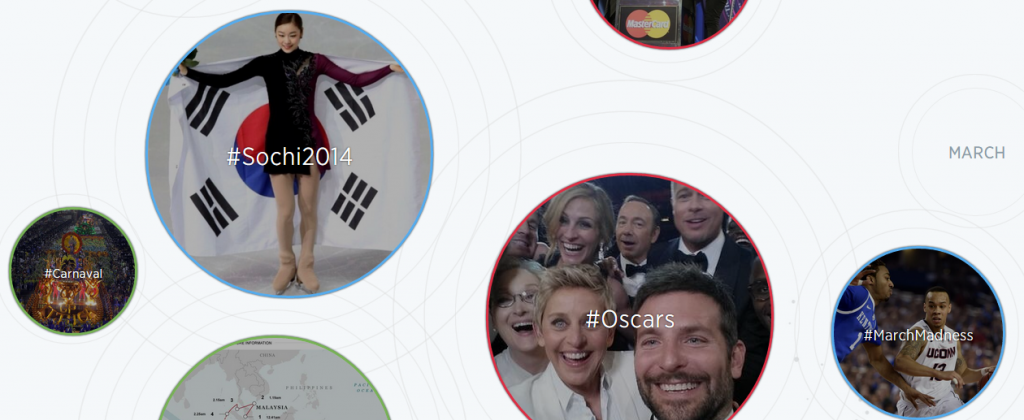
Explore the full website about everything that happened on Twitter this year: https://2014.twitter.com/moments
Google Search
Where would we be without Google? Here is how the world searched on Google in 2014
Read more about what the world searched for on Google in 2014 and explore the stories in more detail with Google Trends 2014.
Your 2014 Year in Review
What have you loved doing in 2014 that you have shared with the world on social media? Let us know in the comments below. Here is to an exciting 2015!
by Michael Cropper | Jun 3, 2014 | Social Media, Tracking |
Ok, we’ve all been there, jumped on social media channels for 5 minutes then looked at the clock and wondered where the last hour went. What we’re going to talk about in this blog post is about the importance of UTM tracking parameters and how they can be used to accurately track social media activities.

What are UTM Tracking Parameters?
Unless you are quite a savvy digital marketer you may not have come across UTM tracking parameters previously, so before we look at how they link in with social media we will run through a short history and technical lesson. UTM stands for Urchin Tracking Monitor. Urchin was the predecessor to what is now known as Google Analytics which we all know and love.
One of the core pieces of technology underlying both Urchin, and now Google Analytics, is the ability to clearly track information about where a website visitor came from when they landed on your website. This core functionality was extended to allow business, brands and marketing managers to customise this information as they please. What all of this means is that UTM tracking parameters allow traffic to your website to be tracked accurately.
The UTM tracking parameters are the additional bits of information that you may have seen in website addresses as can be seen in the example below;
www.contradodigital.com?utm_source=www.bbc.co.uk&utm_medium=referral&utm_campaign=cool-tech-review
What you will see in the website address above is three additional pieces of information, the UTM tracking parameters;
- utm_source: i.e. where did this user come from
- utm_medium: i.e. what type of traffic is this – direct, referral, social, organic or paid
- utm_campaign: i.e. was this from a specific marketing campaign that you ran
In addition to the required parameters above, you can also further customise the information by adding additional information such as;
- utm_term: i.e. if this was from a paid advertising campaign where you bid on specific keywords, such as with Google AdWords
- utm_content: i.e. if you wanted to test different Ad Variations for your paid advertising campaigns, you can track this back with this parameter
Ok, so you may be wondering what this has to do with social media. Before we go onto that, just a bit more important technical background information that you need to understand before we look at how this links in with social.
How referral traffic is tracked within Google Analytics
By default, Google Analytics handles all of the magical UTM tracking parameters in the background (and much more) automatically if a URL doesn’t have anything specified. For example, if a user visits www.contradodigital.com without any UTM tracking parameters in the URL, then Google will see what information they have available about where this person came from and use this to feed into the correct buckets of information within Google Analytics automatically.
For example, if a user came from organic search, then Google knows this and that is why you see website traffic classed as ‘Organic’ and from ‘Google’ within Google Analytics. Likewise, if a user clicks on a link on an external website and lands on your website, then this would be classed as referral traffic within Google Analytics.
The reason why Google Analytics is able to understand this is due to the way web browsers work. When you browse the internet, web browsers pass basic information between websites such as the domain name where you came from.
For example, you can see a page we shared on our Twitter account recently;

Webpage we shared on our Twitter account
The shortened website address con.tra.do/TPz3K9 is actually the following website address https://www.contradodigital.com/resources/social-media-tracking-tool/?utm_source=Twitter&utm_medium=Social&utm_campaign=Our-Social-Updates and as you will notice, this has included the UTM tracking parameters in the URL.
This isn’t what I want to talk about here though. Hidden away in the browser when a user actually clicks on this link is additional information within the HTTP Header which contains information for the website where the user is going to, i.e. in this example our website. Below is a screenshot of the HTTP Header information when a user clicks on the link;
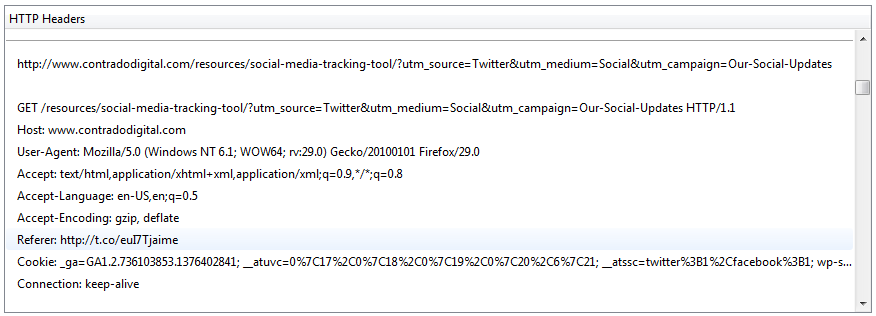
HTTP Header Referer Information Example
What you will notice in the highlighted line is the Referer information. Yes, you will notice that is actually spelt incorrectly and there is a rather interesting story behind this if you are interested and wondering why this is still widely used.
The referrer information is telling the website that you are landing on the full website address where the user came from. So in this case, this is http://t.co/euI7Tjaime which is the automatically shortened URL that Twitter now uses.
What this means is that within your Google Analytics account, if you didn’t use UTM tracking parameters, then the traffic would be listed as from t.co, opposed to twitter.com. This is due to the automatic shortened URL that Twitter uses.
You may be wondering why this is a problem. Traffic from twitter is coming from t.co, which we know to be Twitter. So why is this a problem for us? Well, glad you asked.
Optional Referrer Information
The reason why this is a problem is that the referrer header information is optional, meaning that it may not always be present depending on where and what ‘thing’ the user came from. This generally isn’t too much of a problem for modern browsers as they do support this by default. The problem lies with the range of technologies people are using to access information on the internet.
For example, 80% of Twitter users in the UK access the service from a mobile phone. This is huge. A large of these people will be using native mobile applications on their devices, opposed to visiting the www.twitter.com website to use the service.
What this means is that the referrer header information often isn’t passed along when a user clicks on a link. So when a user is flicking through their Twitter feed over coffee in the morning and they see a link to some amazing content you have on your website, then this traffic will be potentially be classed as direct traffic within Google Analytics. Wait. What? This isn’t right. This is the key point to take away from the blog post.
Direct traffic within Google Analytics isn’t people who typed in www.your-website.com into their browser. No. Direct traffic is actually Google’s way of saying ‘we have no idea where this traffic came from’.
This may be difficult to grasp just reading through this quite technical blog post, so let’s illustrate this for clarify. We have been focusing on Twitter throughout this blog post, although this isn’t just Twitter where this problem lies. This is a large scale tracking problem that can only be solved with using correct UTM tracking parameters on your URLs.
Missing Referrer Information
To illustrate the point above, I picked up my phone (Samsung Galaxy S4), opened the Facebook application that I have installed and navigated to the Contrado Digital Facebook page as can be seen below;
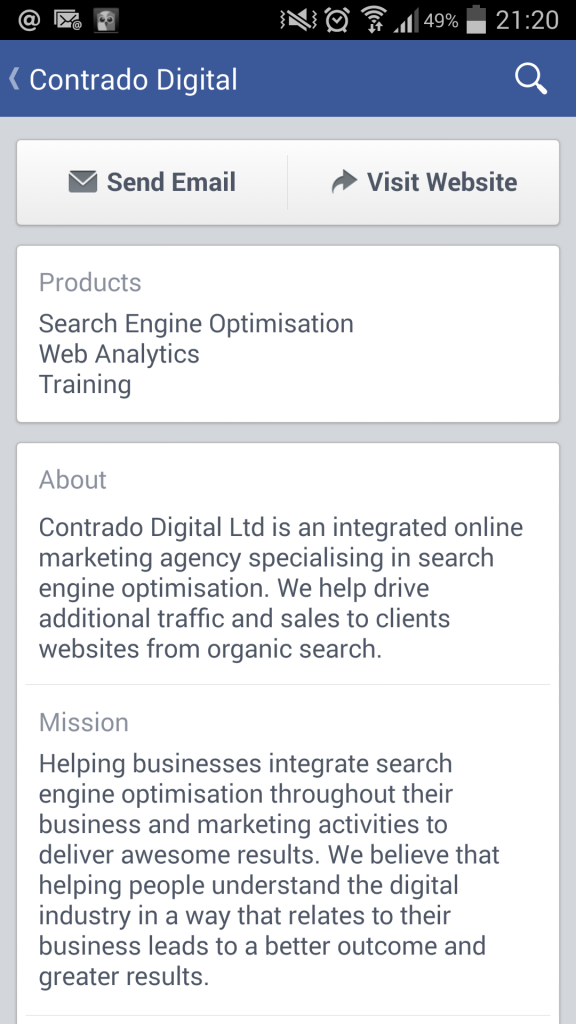
Contrado Digital Facebook page as viewed from a native mobile application on phone
I then clicked on the ‘Visit Website’ link. Now imagine this was a normal status update that you shared a link to your website, this is the same thing. Then I headed over to Google Analytics to view the Real Time Analytics report which shows who is on the website right now, and most importantly where they came from;
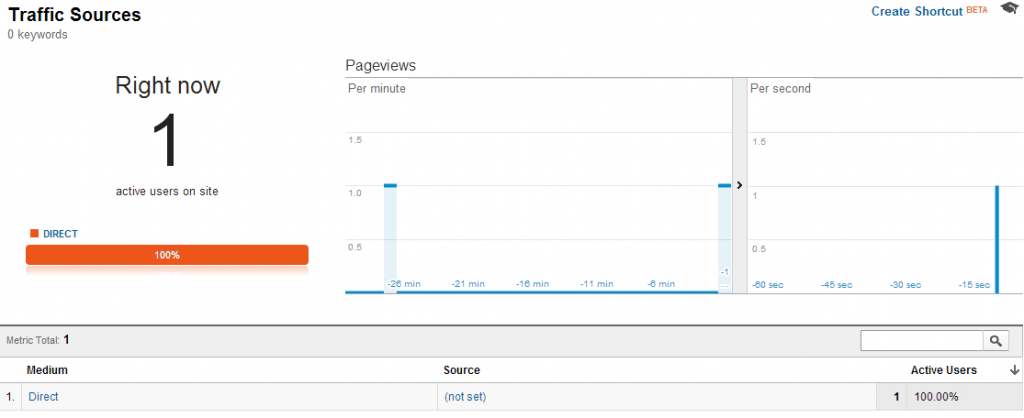
Google Analytics Real Time traffic report no referral data from Facebook native mobile application
What you will notice here is that the medium is set to ‘Direct’ and the source is ‘(not set)’. This isn’t good. This should be set to ‘Social’ and ‘Facebook’ respectively. What this means is that you will be receiving traffic from your social media channels, although you won’t know that it is from your social media channels if you don’t tag your URLs up with UTM tracking parameters correctly.
If you are spending a reasonable amount of time implementing your social media strategy, then you want to know that it is delivering results. I repeated the same process, although on our Twitter account and this traffic is actually coming through correctly from the mobile application that I am using as can be seen below;
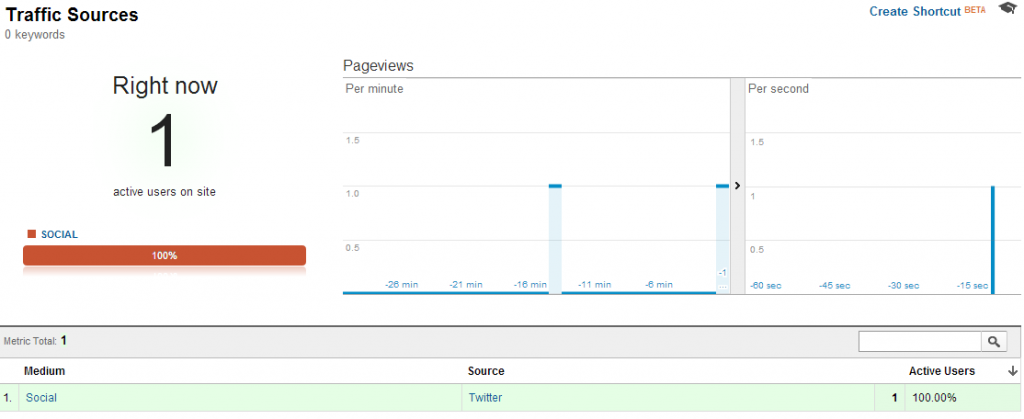
Google Analytics Real Time traffic report shows referral data from Twitter native mobile application
What this does highlight is the inherent discrepancy between different native mobile applications and that some will and some won’t pass on the referrer header information for the website to pick up on. If I was to repeat this experiment using a different mobile application that was pulling in Tweets or social media updates, then the response will likely be different again. Likewise, if I was to repeat the experiment on an Apple iPhone then again the results would likely differ.
The Solution
What you will hopefully have picked up on throughout this blog post is that unless you are using UTM tracking parameters on all URLs that you share on social media channels then you will not be getting a full picture about how your social media marketing efforts are performing.
Thankfully, you’ll be glad to know that there is a simple and effective solution. That is to use our Social Media Tracking Tool which will automatically add on the relevant UTM tracking parameters for the main social media channels you will be using.

Social Media Tracking Tool
What this means is that when you share correctly tagged up URLs on your social media channels, you will be able to see within Google Analytics exactly where the user has come from. I.e. Twitter, Facebook, Google+, LinkedIn or Pinterest. No longer will you have to guess where traffic is coming from. Tag your URLs and track the data accurately.
While UTM tracking parameters are very simple in their nature, the underlying technology behind them can get quite technical. If you have any questions or comments on the above then leave a comment below.
Have fun tracking all of your social media updates accurately from now on!
by Michael Cropper | May 25, 2014 | Data and Analytics, Social Media |
Social media is an extremely powerful medium that allows you to connect with your audience even easier than ever. While this is true, most businesses are still unsure about how to use social media effectively and how to track social media activities. It is easy to spend a lot of time on social media without knowing what your business is getting back from the time invested.
Here we will talk you through a few tools that we use, and one that we have built, which are all designed to help you manage your social media work effectively. No longer will you have to use guess work to measure performance, instead you can use these selection of tools to track all social media activities effectively.
Ok, so you’ve just created some awesome content on your website or blog and now you want to share this with the world on your various social media channels. Firstly, it is important to tag all of your links up that you are sharing so that you can easily see how many people have clicked on these links from the various social media channels.
Social Media Tracking Tool

To tag up your URLs that you are sharing you can use the Google URL Builder if you have custom and individual requirements, or alternatively you can use our new Social Media Tracking Tool. This tool is designed to speed up the process for updating social media channels and tracking the number of clicks received from the different channels.
By default, links that aren’t tagged will not be tracked accurately within your web analytics tool such as Google Analytics. The reason behind this is due to the ‘referrer’ information not always being passed from the source through to your website when a user clicks on the link from various sources including native applications, i.e. a Twitter App on your followers’ smartphones. When this happens, it will appear that traffic to your website from social media channels is ‘Direct’ traffic, which isn’t the case.
Our new tool will tag all of your links up automatically, saving you time manually updating each link with the correct campaign tracking tags. Have a go and see how easy the tool is to use.
Bit.ly
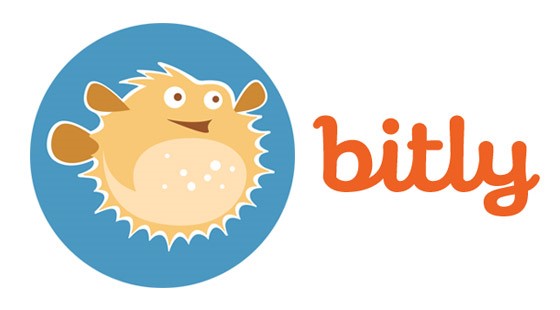
Another tool that you will find useful for tracking your social media activities is Bit.ly which is an additional link tracking tool that sits between users clicking on a link that you have shared on social media and when they arrive on your website. This is a great tool to use as this means you can track the number of clicks the links you are sharing on social media, regardless if these links are to your website or another website. Below shows the daily clicks for our social media activities over the last month;

As can be seen above, this is great data to understand what your fans and followers are most interested in reading about. Knowing this information will allow you to tailor your social media updates to content that is most interesting for your audience.
Buffer

Now you have your list of links that you want to share on social media, you can easily schedule these updates to save you having to spend all day on social media. Simply schedule posts to be sent out automatically throughout the week and save yourself hours of time, allowing you to continue running your businesses.
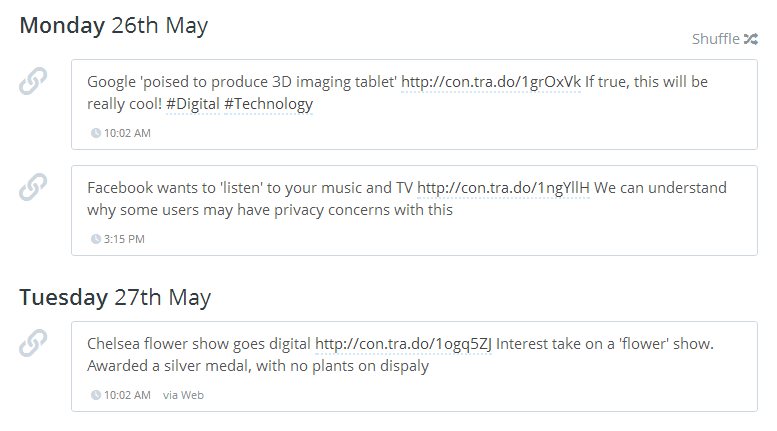
As you can see above, here are a few of the scheduled posts we have. With this tool you can easily set custom schedules for each of the social media accounts that you connect to Buffer. The simplicity of this tool is brilliant and really does all you to save an enormous amount of time managing your social media activities.
HootSuite

Now you have all of your content scheduled to your social media channels, you need an easy way of managing engagement from your fans and followers. While you can simply hand out your login details to several members of staff to manage social media for you, this will inevitably lead to challenges. For example if a member of staff leaves your business, you will have to change the passwords. In addition, you may have an external party like ourselves managing your social media channels and you would prefer we didn’t have your passwords.
Tools such as HootSuite get around these issues by being able to manage social media channels without logging in/out of each social media account through the day. This really helps to reduce the management time along with increase the response time when responding to fans and followers on social media.
As you may already know, we are an official HootSuite Solutions Partner so we are confident in the tool and its abilities. Being able to manage multiple social media channels from a single dashboard is ideal and there is also the flexibility to allow members of staff to do this from their own HootSuite account too. Meaning that you can easily manage a team of people working on the social media activities. Below shows you how simple the tool is to use;
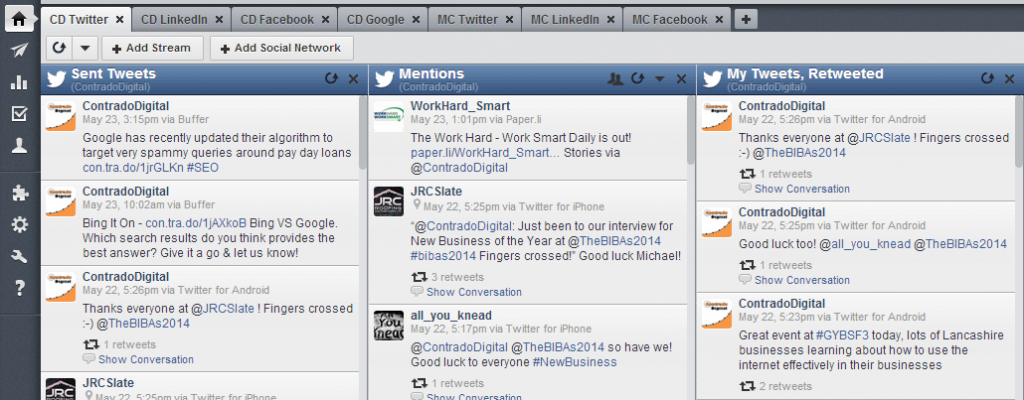
Google Analytics
Now you have all of your social media activities working well, tracking is the essential part of this. Tracking is available within all of the tools mentioned above so it is always recommended to monitor each of the individual tools. Social media can be a great way to drive additional traffic to your website and as mentioned earlier, our new Social Media Tracking Tool allows you to easily track this data within tools such as Google Analytics.
Below shows a graph from our Google Analytics account for the traffic our website has received over the past few months as a direct result of talking about our blog posts we have promoted;

This traffic is broken down in Google Analytics based on the way that you tagged your campaigns. Thankfully with our new Social Media Tracking Tool, you don’t have to worry about this as the tool will automatically tag all of your campaigns quickly and easily for you.
Once you start to use this approach with your social media activities you will be able to quickly see which channels are driving the most traffic to your website. Most importantly, this traffic data will now be accurate since if campaign tracking tags aren’t used, then this is likely to be under-reporting on the results the social media activities are generating.
Summary
Overall, social media management doesn’t have to be an extremely time consuming task. Instead, using the right tools for the job can save a huge amount of time and allow you to focus on other areas within your business. To summarise the tools and steps below;
1) Social Media Tracking Tool: Use to automatically tag all your links up correctly when posting updates to your various social media channels
2) Bit.ly: Use to see how many people are clicking on the links you are sharing, whether these links are to your website or to an external website
3) Buffer: Use to easily schedule social media updates throughout the week without having to continually post throughout the day
4) HootSuite: User to easily manage engagement from your fans and followers by joining the conversation when the time is right
5) Google Analytics: Use to accurately track which social media platforms are driving the most traffic to your website. Ensure campaign tracking tags have been set up using our Social Media Tracking Tool so you aren’t under-reporting on results achieved
Hopefully this has given you a good selection of tools and explained clearly how these various tools can be used to manage your social media activities effectively. Save yourself a huge amount of time using the above tools.
These tools are our preference when managing social media channels, if you have any other tools that you like to use, then leave a comment, we’d love to hear from you.
by Michael Cropper | Dec 14, 2011 | SEO, Social Media |
One of my pet hates about websites is when they make it difficult or impossible to share their content on social media. Please webmasters & companies, come into the 21st century and understand how important sharing content is. Lets take a look through a few different websites and what sharing options they have on their site.
Websites With Poor Social Sharing Options
PC World
Looking at the product pages on PC World, the only options for a user are either to print or email the page. They are missing a massive opportunity by not including some of the more social buttons such as AddThis, Facebook Like button or the Tweet button.

Expedia
Expedia do a little better than PC World since they offer the ability to Like / Send buttons from Facebook, although what about if I want to share the content on Twitter or StumbleUpon?
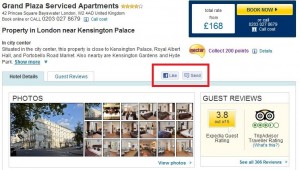
JJB Sports
JJB Sports have a better implementation of social sharing buttons than the previous websites listed as you can see below. They have included the AddThis button, Tweet button, Google Plus One button and the Facebook Like button. It doesn’t appear to have gained much traction so far since most of the products I viewed had no social shares, although I did only look through a handful of random product pages.

Google
With Google having recently launched their own social media platform, Google Plus, their Plus One button has been showing up everywhere and almost forcing people to begin to Plus One different websites. Here is an example of one of their Google Webmaster Guidelines posts and you can see that they have actually been nice to the other platforms (for a change!) and given users the ability to share the content on a range of platforms.
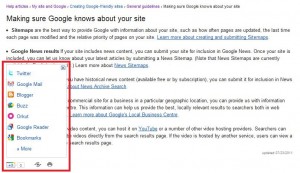
They have also integrated the Plus One button into the search results to try and get more people to use it, although more recently this has disappeared and will only appear when you mouse over a listing.

Whether you agree with how Google is pushing their own services or not, this is a good implementation of social sharing.
Website With Great Social Sharing Options
Now we can take a look at some websites who have nailed social sharing on the site, so much so that the number of shares their content gets of phenomenal.
SEO Book
SEO Book do a fantastic job of making social sharing buttons very visible, which is one of the reasons why their content is shared a lot. Below is an image of their recent blog posts and you can see it has had over 700 social shares, and likely many more which aren’t directly listed.
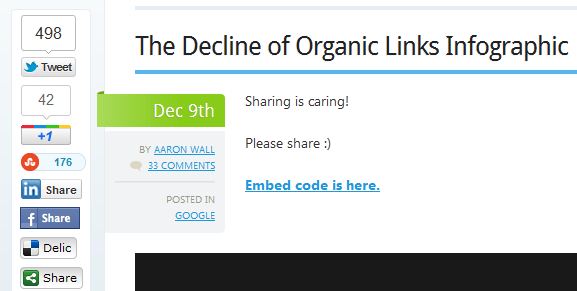
Search Engine Land
Search Engine Land do a good job of social sharing buttons as well, with the main sharing buttons placed above the story then additional sharing buttons offered by Share This at the end of the article. This way, the most frequently used buttons are easily identifiable without cluttering the page and the additional less used ones are still available.
Main social sharing buttons;

Other social sharing buttons at bottom of page;
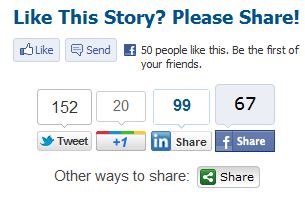
Search Engine Round Table
Search Engine Round Table also do a great job of social sharing in a very similar way to how SEO Book implement it. They also list the main social sharing buttons with the additional option to share more content via theAdd This button. The screenshot below was taken approximately 6 hours after the content was put online, so not bad to generate 60+ social shares within that time. I certainly couldn’t build that many links manually in such a short space of time!
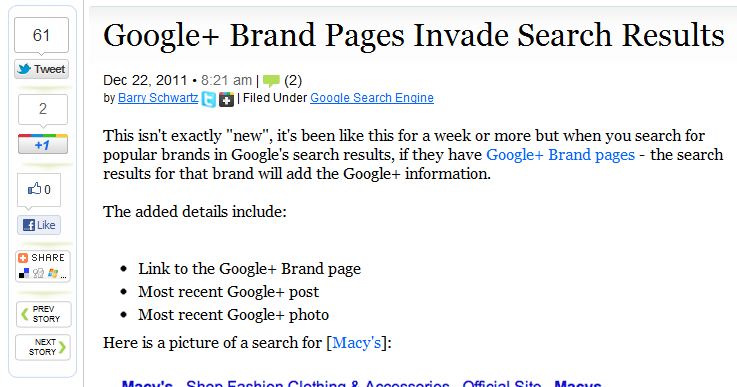
Hotels-London
Over at Hotels-London.co.uk we have recently introduced some fantastic (if I do say so myself!) social sharing options so a user can easily see how to share the content throughout the site. The image below is a toolbar which is always visible at the bottom of every page and allows customers to create nice friendly shortlists and view recently viewed hotels. Go check it out, its ace 

We also have the Add This button installed throughout the site in prominent places which allows the user to share via other popular social services.

Why Add Social Buttons?
If you website doesn’t excel at social sharing or you are still in doubt about why you need to be using social sharing buttons then here are some obvious tips about why you need to be promoting them;
- Social sharing helps promote your brand to more people FOR FREE. When a user shares the content on Facebook or Twitter, this content (and your brand) is then seen by all of their friends, family, followers and fans. Imagine the cost of trying to advertise to all of these people…
- By allowing people to share your content, they are likely going to come back and visit your website again. I personally use Twitter as a ‘read later’ list when I re-tweet random things that I spot. Other people will email things to their self for reading later at, generally when they spot something interesting (such as a nice holiday!) in works time and don’t want to get caught by their manager browsing this.
- Social signals help your SEO efforts!
- Social involves real people in the real world who are going to share and talk about your brand with other real people. The more real people you can get involved with your brand the better. This will ultimately lead to more sales, as long as people are talking about you for the right reasons!
- When someone has just purchased a product, left a review or commented on some content then they like to brag about it. Let them tell their friends about it, it will ultimately result in more people coming to your website.
Here is a great example illustrating the last point. The example is when you have purchased an item on Amazon.
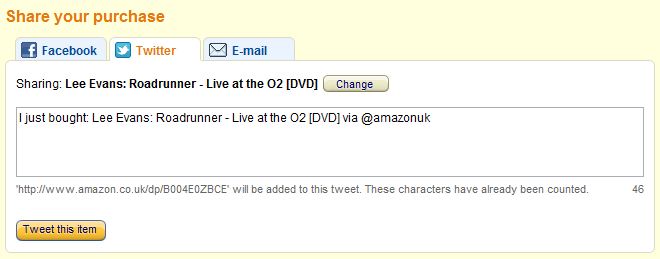
When it comes to link building, there are a couple of options
Option 1: Manually build low quantity and quality of links
Option 2: Build and promote great content which will attract natural links.
I certainly know which I would prefer to do. Get the great content and promote well, since this starts the ball rolling for content to be seen by many more people when it is shared over social media.
I hope this gives you something to go off and some good examples about the different options available. Most importantly is just getting something there at least, you can always improve on it later. For example, the Add This button takes literally less than 5 minutes to set up and install site wide. Just get it done. 


































Nice one!
I must admit I frequently share my Amazon purchases, just to show off what awesome things I buy ;-).
The only point I’d like to add is that you should check where your audience is, before blindly implementing all kinds of social services. Should JJB Sports offer LinkedIn Share? Possibly not. Do put social buttons on your site but don’t necessarily overwhelm your users with too many (unnecessary) choices :).
Very good point Felix! Knowing who your customers and how they use your services is imperative. Just as adding a LinkedIn Share button onto a children’s TV show website wouldn’t really provide much use.
Great article Michael! I’m all for introducing share buttons as long as the WHAT (type of button) & WHY (the objective) & WHERE (on the page) have been considered for each page of your site. It’s really important to bear in mind the customer journey particularly on e-commerce sites and ensure you are not distracting them from completing the purchase. Would be great to hear the performance those share button had for Hotels-London. ????
As soon as we have some good stats through about the performance I will add a few more details to the blog post. The data within the first couple of days was promising though.